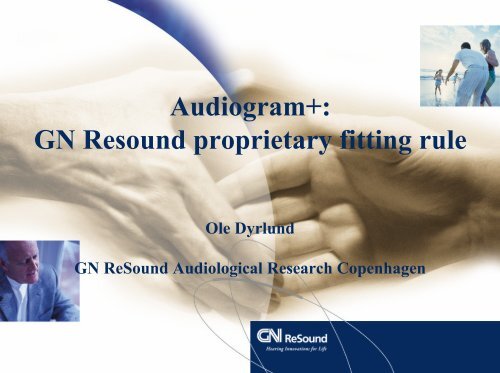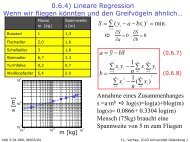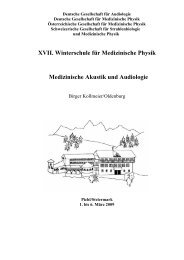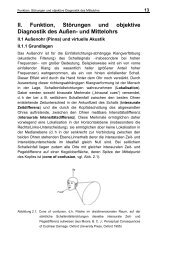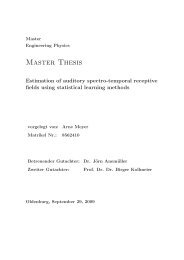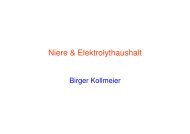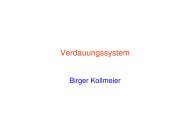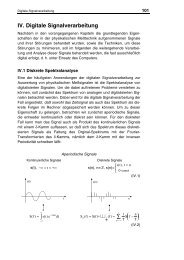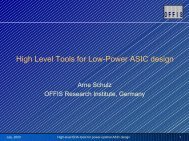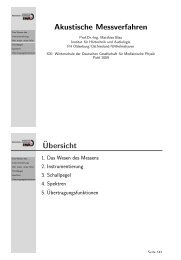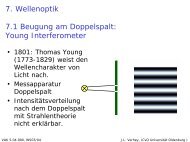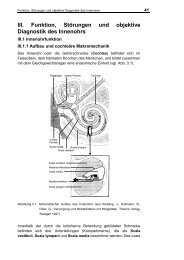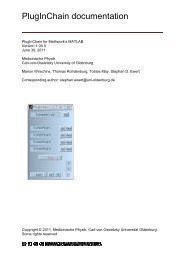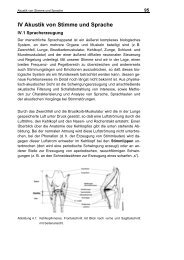Audiogram+: GN Resound proprietary fitting rule
Audiogram+: GN Resound proprietary fitting rule
Audiogram+: GN Resound proprietary fitting rule
Create successful ePaper yourself
Turn your PDF publications into a flip-book with our unique Google optimized e-Paper software.
<strong>Audiogram+</strong>:<br />
<strong>GN</strong> <strong>Resound</strong> <strong>proprietary</strong> <strong>fitting</strong> <strong>rule</strong><br />
Ole Dyrlund<br />
<strong>GN</strong> ReSound Audiological Research Copenhagen
Loudness normalization - Principle
Background for <strong>Audiogram+</strong><br />
<strong>Audiogram+</strong> is a loudness normalization <strong>rule</strong> adapted to the<br />
14 band compression system in Canta based on clinical<br />
trials.<br />
– Allen J.B., Hall J.L., Jeng P.S. (1990)<br />
<strong>Audiogram+</strong> calculates gain targets at the 11 audiometric<br />
frequencies for 50 and 80 dB SPL inputs based on air<br />
conduction thresholds and a number of additional factors.<br />
Gain targets provide an optimal trade-off between speech<br />
perception and listening comfort
Speech perception with <strong>Audiogram+</strong><br />
Percent Correct<br />
100<br />
80<br />
60<br />
40<br />
20<br />
0<br />
Speech-in-Noise Test Results<br />
CIC (n=18) ITE/BTE (n=33) PBTE (n=21)<br />
Model<br />
“Own” aids are a selection of digital and programmable instruments<br />
Unaided<br />
Own<br />
Canta-P1<br />
Canta-P2
14 Band Compression system
Effect of input signal for 14 band system<br />
Difference relative to sine (dB)<br />
0<br />
-5<br />
-10<br />
-15<br />
-20<br />
-25<br />
Broadband vs. sine input for<br />
same overall level<br />
0 5 10 15<br />
Band number<br />
White noise vs. sine<br />
input<br />
Speech shaped vs.<br />
Sine input<br />
At 1kHz broadband<br />
input is 9 dB lower<br />
than sine input
Broad band vs. sine band input<br />
Insertion gain dB<br />
Frequency<br />
Broad band Input<br />
Sine Input<br />
50 dB Input<br />
80 dB Input
<strong>Audiogram+</strong>: Additional factors taken<br />
into account<br />
Severe Hearing Losses<br />
Ski-slope Hearing losses<br />
First Time Users<br />
Air-Bone Gap<br />
UCL<br />
Age<br />
Previous type of amplification
Accuracy of <strong>Audiogram+</strong><br />
•Very accurate prediction of average desired<br />
amplification for mild, moderate and severe<br />
losses<br />
•Standard deviation twice as high for severe<br />
hearing losses, meaning more fine-tuning is<br />
needed for these losses.
Prescribed versus fine-tuned gain (mild to moderate HL)<br />
Desired extra gain (dB)<br />
20<br />
15<br />
10<br />
5<br />
0<br />
-5<br />
-10<br />
-15<br />
100 1000 10000<br />
Frequency (Hz)<br />
Mean differences and standard deviation (SD) between <strong>Audiogram+</strong> prescribed gain<br />
targets and the final gain setting preferred by test subjects. Blue line: 80 dB inputs, blue<br />
dotted line: corresponding Standard Deviation. Black line: 50 dB inputs, black dotted line:<br />
corresponding Standard Deviation.
Prescribed versus fine-tuned gain (severe HL)<br />
Desired extra gain (dB)<br />
20<br />
15<br />
10<br />
5<br />
0<br />
-5<br />
-10<br />
-15<br />
100 1000 10000<br />
Frequency (Hz)<br />
Mean differences and standard deviation (SD) between <strong>Audiogram+</strong> prescribed<br />
gain targets and the final gain setting preferred by test subjects. Blue line: 80<br />
dB inputs, blue dotted line: corresponding Standard Deviation. Black line: 50<br />
dB inputs, black dotted line: corresponding Standard Deviation.
Can prescription accuracy be<br />
increased for severe and profound<br />
losses?
Design<br />
Fitting data from several test sites were divided<br />
in two groups according to previous use of<br />
linear amplification or fast acting WDRC<br />
Target prescriptions calculated by the original<br />
<strong>Audiogram+</strong> algorithm were compared with the<br />
gain preferred by the users<br />
Comparison was carried out at 0.25, 0.5, 1, 2, 4<br />
and 6 kHz.
Test subjects<br />
59 users of fast acting WRDC<br />
36 users of linear hearing aids<br />
All users binaurally fitted<br />
All experienced users of hearing aids
Extra gain (dB)<br />
45<br />
40<br />
35<br />
30<br />
25<br />
20<br />
15<br />
10<br />
5<br />
0<br />
-5<br />
-10<br />
-15<br />
Previous nonlinear users, 0.5 kHz<br />
y = 0.0932x - 1.4607<br />
y = 0.0749x - 0.1417<br />
0 20 40 60 80 100 120<br />
Hearing loss (dB HL)<br />
G(80)<br />
G(50)<br />
Linear (G(50))<br />
Linear (G(80))
Extra gain (dB)<br />
45<br />
40<br />
35<br />
30<br />
25<br />
20<br />
15<br />
10<br />
5<br />
0<br />
-5<br />
-10<br />
-15<br />
Previous linear users, 0.5 kHz<br />
y = 0.2929x - 7.5298<br />
y = 0.2034x - 4.2815<br />
0 20 40 60 80 100 120<br />
Hearing loss (dB HL)<br />
G(80)<br />
G(50)<br />
Linear (G(50))<br />
Linear (G(80))
New <strong>rule</strong>: Example<br />
100<br />
0<br />
10<br />
20<br />
30<br />
40<br />
50<br />
60<br />
70<br />
80<br />
90<br />
100<br />
1000 10000<br />
40<br />
35<br />
30<br />
25<br />
20<br />
15<br />
10<br />
5<br />
T80 (Lin)<br />
T50 (Lin)<br />
T80 (Nonlin)<br />
T50 (Nonlin)<br />
0<br />
100 1000 10000
Accuracy of improved <strong>fitting</strong> <strong>rule</strong><br />
Mean difference and SD between preferred<br />
<strong>fitting</strong> and prescription:<br />
G(80) G(50)<br />
HTL 250 500 1 2 4 6 All 250 500 1 2 4 6 All<br />
Linear 65 Diff. 1 2 0 -1 0 0 0 1 1 -2 -2 -1 -2 -1<br />
SD 11 9 7 8 9 9 9 11 6 4 5 6 7 6<br />
Nonlinear 65 Diff. 2 1 0 0 1 0 0 -1 1 -1 0 0 -1 0<br />
SD 7 6 6 6 6 6 6 7 7 5 6 6 6 6<br />
Previous 65 Diff. 1 0 1 2 4 4 2 0 0 0 0 1 2 1<br />
SD 11 9 8 10 10 10 10 9 8 5 7 9 9 8
Accuracy of improved <strong>fitting</strong> <strong>rule</strong><br />
SD dB<br />
10<br />
9<br />
8<br />
7<br />
6<br />
5<br />
4<br />
3<br />
2<br />
1<br />
0<br />
80 dB Input 50 dB Input<br />
>65 Linear >65 Non-Linear >65 Combined
Conclusion<br />
<strong>Audiogram+</strong> is tailored to the <strong>Resound</strong><br />
compression system (channels, time constants)<br />
<strong>Audiogram+</strong> gives an optimal trade-off between<br />
speech perception and listening comfort and a<br />
high prescription accuracy.<br />
Tested in a large number of clinical trials<br />
For severe hearing losses use of separate<br />
prescriptions for previous users of linear and<br />
nonlinear amplification improves the<br />
prescription accuracy.


